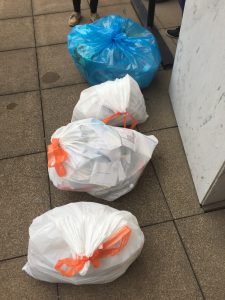
Garbage bags from selected household
In order to investigate the garbage of the selected Atlanta household, our group created a system to label bags and items. The blue bag, mainly full of recycled plastic and cardboard, was bag #1; the white bag next to it, full of food remains and non-recycled trash, was bag #2; and the white bag next to that, holding recycled paper, was bag #3. The fourth bag pictured was not used because the group had enough information from the first three bags.
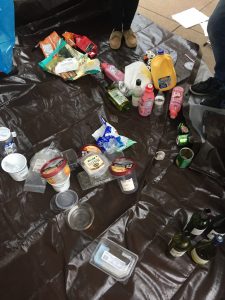
Recycled plastic and bottles from bag #1
The contents of the bags were sorted, documented, and categorized to make any trends in the garbage more noticeable. Many of the items in bag #1 were containers that held imported products and containers with foreign- sounding brand names to appear authentic. These garbage items tell us how prevalent globalization is today, and how brands that are not imported try to appear so to attract customers.
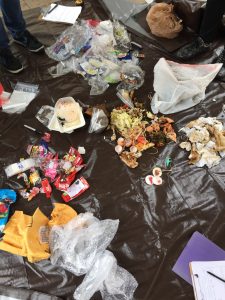
Assortment of food remains and other trash from bag #2
The food and general garbage remains from bag #2 revealed information about the consumerist habits of the family, such as which products are purchased multiple times and where the household normally shops. The household prefers organic products and products from the Dekalb farmers market and Publix, indicating that they value healthy, local food options. Other observations could be made as well, such as that the household really enjoys coffee and the household celebrated Valentine’s Day recently.
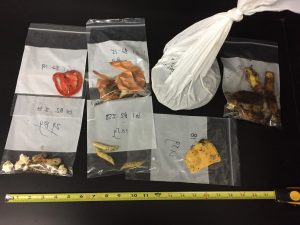
Food remains and a bag of cat litter from bag #2
The demographics of the household were determined through bag #3 of paper recycling and the trash in bag #2. The group discovered that a man, a woman, at least one child, and at least one cat live in the house. Socioeconomic status was also evident in the amount and variety of foods that were thrown away. The family could afford to waste fresh fruits and vegetables.
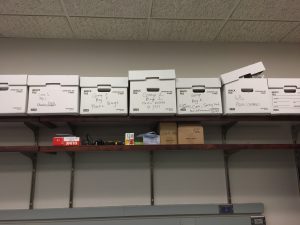
Boxes full of documented garbage items
The garbage that the group studied reflected the household demographics, socioeconomic status, consumerist habits, and globalization and trade in today’s world. What we throw away and what we don’t reveals a great deal about who we are and what we value.